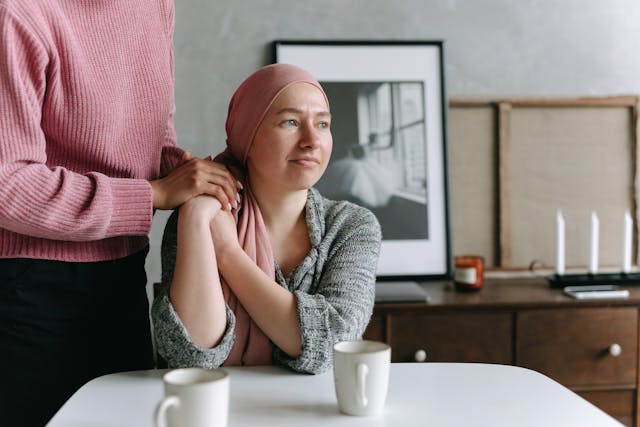Photo Source: https://www.pexels.com/photo/a-person-holding-hands-with-a-woman-7659552/
Cancer treatment can heavily weigh upon the body of a person, leaving it with symptomatology that a patient really cannot bear. More than the primary medical management of chemotherapy and radiation used to treat cancers, an individual finds help in making use of adjunctive techniques that address his symptoms better and improve his quality of life. These complement the major treatments to treat pain as well as manage nausea, but also to work on bringing emotional well-being. Listed below are eight effective ways of complementary use to relief cancer symptomology.
Acupuncture for Pain and Nausea Management
Acupuncture is one of the popular techniques that has recently become in vogue because it promises to reduce pain and nausea, two of the most common side effects of cancer treatments. Thin needles are introduced into specific points on the body to stimulate the natural healing processes of the body. It has been found to help alleviate symptoms without too much reliance on pain medicines that can cause side effects from their use. Most patients who see regular acupuncture treatments report improved general well-being and the reduction of pain.
Mindfulness Meditation
The emotional toll of diagnosis with cancer is high, and mindfulness meditation is a mode to deal with stress and anxiety. In mindfulness, the patient trains the mind to rest on the present, attaining awareness of the feeling without letting it overwhelm oneself. This has an impact on the brain: It promotes a soothing and balanced state of mind and, as studies show, has been known to lessen cortisol levels and strengthen a patient's resilience. On a regular basis, more peaceful sleep and more control over emotions are some added benefits that make a treatment cycle better.
Aromatherapy Helps Reducing Stress Levels and Mood Swings
Aromatherapy treats a patient with calming conditions and reduces symptoms of stress, nausea, and insomnia with essential oils of lavender, chamomile, or eucalyptus. The olfactory system is stimulated by way of inhalation or application on the skin. They can be very helpful in promoting relaxation. For those with cancer, a small amount of lavender oil seems to make a huge difference in being able to relax or sleep well. This soft, natural approach is wonderful for those who want non-invasive methods in which to enhance mood or comfort during treatment.
Yoga for Physical Strength and Flexibility
Patients undergoing cancer treatment normally become weak and feel heavy, and yoga, though not strenuous in action, can help patients rebuild strength and flexibility; by improving circulation and offering a mindful approach, yoga provides both physical benefits as well as emotional effects for patients to relate comfortably with their bodies. Practice repeatedly reduces muscle stiffness and builds relaxation, helping patients overcome fatigue and various other side effects that define the treatment process.
Dietary Change for Optimal Nutrition and Energy
A healthy diet can significantly improve the quality of life for cancer patients. A diet rich in fruits, vegetables, and lean proteins can boost energy levels, reduce inflammation, and strengthen the immune system. Some individuals believe that a diet free of processed foods and rich in organic produce can be a powerful non-toxic cancer treatment. Consulting with an oncology nutritionist can help tailor a personalized diet plan to meet specific nutritional needs and enhance overall well-being.
Music Therapy as Pain and Anxiety Relief
There is no invasive nature to music therapy, thus using it to manage pain and reduce anxiety during cancer treatment. Listening to or creating music has a soothing effect that lowers heart rates while creating relaxation. Music therapy allows a patient the creativity to take charge of their emotions in an attempt to control emotional responses. It provides relief. Many hospitals offer a session of music therapy when a patient receives treatments there, as its benefits will go from emotional relief to even actual physical pain relief, thanks to endorphin release.
Massage Therapy to Relieve Muscle Tension
Massage therapy can be comforting and helps ease muscle tension and improve circulation, which may be altered by cancer treatment. The oncology massage therapist will work around many of the sensitive areas but still provide relief from pain and achieve relaxation. Such treatment would be useful for a cancer patient on chemotherapy or radiation because it reduces tension, improves circulation, and exerts no additional pressure on the body.
Tai Chi for Balance and Mind-Body Connection
Tai Chi is a soft martial art, where it is focused on slow movements and regulated breathing. Tai Chi may be the perfect exercise that would help improve balance in cancer patients and enhance mental clarity. Being a mind-body connection practice, Tai Chi allows a cancer patient to have a less stressful mind with improved balance and muscle tone. This ancient practice has promised to help the patient alleviate feelings of fatigue and depression, and controlled movement gives patients an easily available means of exercise during each step of treatment.
Conclusion
Complementary therapies in acupuncture, yoga, and aromatherapy have become increasingly used to complement traditional treatments and enable patients to better cope with the symptoms of their diseases and improve their general condition. Although these modalities do not supplant traditional medicine, they can decrease symptoms and allow the patient to gain mastery over their disease. These therapies can be discussed with your provider to determine whether they might be an appropriate part of your treatment plan. A patient using conventional and complementary therapies can create a comprehensive treatment program that assists them both physically and emotionally as they navigate their disease process.





Comments